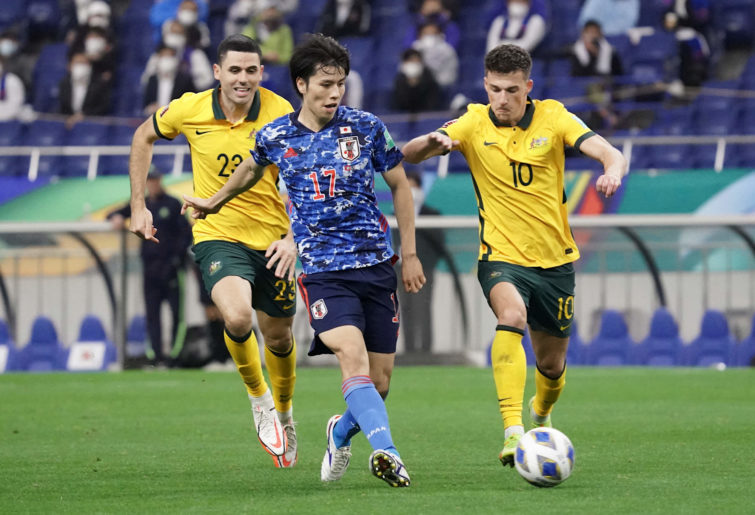Young excellence, promotion battles, and a happy farewell: The Australian team of the week from players around the globe
Even though St.Pauli ultimately lost a high-scoring affair, Jackson Irvine was a standout, as well as scoring a late goal.
Opinion
The recent match against Japan clearly showed Australia’s weakness in attack on the night. But if better players had been selected, they could have posed much more of a threat.
Instead, what we saw seemed to be a repeat of the World Cup squad sent to Russia or the Asian Cup squad sent to Qatar in 2019.
The goal scoring stats were on a similar level of mediocrity. In the final 2018 World Cup group match against Peru, the players in the starting front four had just 28 goals from 201 games between them, or less than one goal every seven matches.
So, how did the squad against Japan compare?
Up front was Adam Taggart, who was chosen ahead of Mitchell Duke, while Ajdin Hrustic was behind him in the centre. Martin Boyle was on the right and Tom Rogic was on the left, in place of Awer Mabil.
Taggart was in a goal drought going into this qualifying campaign, scoring just once from his 12 previous matches for club and country.
Rogic had scored just one goal from eight matches at club level this season, which was the same as Taggart. Last season, he scored just one goal from 23 matches and the season before that, he scored two goals from 16 matches.
Hrustic had only scored one goal from nine matches for Australia going into the match against Japan and that was from a set piece. At club level, he is yet to hit the back of the net in six matches this season at Eintracht Frankfurt, while he only scored once from 11 matches last season.
In his time at Groningen before that, Hrustic scored just five times over 70 matches across four seasons. That works out to one goal every 14 matches. His goals per match ratios at both clubs were worse than Robbie Kruse.

Ajdin Hrustic has been far from prolific in front of goal (Photo by Koji Watanabe/Getty Images)
The only player in the starting front four who was in good goal scoring form was Boyle, with three goals from seven matches for Australia and six goals from eight matches at club level. But he only made eight passes in the 88 minutes that he was on, showing just how little of the ball that he got.
Even if you looked to players on the bench, it was really only Duke and Mabil who looked any good. Riley McGree has also been out of goal scoring form while Daniel Arzani, Chris Ikonomidis, James Jeggo and Denis Genreau have poor goal scoring stats and shouldn’t be relied on to provide them.
Behind the front four were Aaron Mooy and Jackson Irvine, neither of whom are reliable goal scorers. Once Japan marked Boyle, they had little to worry about defensively and Australia were about as toothless as a gummy shark.
Going forward from here, the squad doesn’t just need minor changes, but a complete overhaul with a strong focus on goal scoring form in the selection process and with an eye on the future.
It’s not as if the talent isn’t there either, or the depth.
Starting with the strikers there’s Jamie Maclaren, Boyle, Nikita Rukavytsya, Alou Kuol and the Toure brothers to choose from, while players such as John Iredale, Patrick Wood and Noah Botic could soon be in the mix.
Wood has just been named in the squad for the next two Olyroos matches. Even Duke is actually going well now, with four goals from eight matches for Australia. He just needs to keep it up.
Across the attacking midfield line, you have players like McGree, Mabil, Hrustic, Yaya Dukuly and Marco Tilio, while the Toure brothers and a few others could easily fit in here, too.
Then, when it comes to options in the double pivot, you have Irvine, Hrustic and McGree from the current squad.
Others to consider are Stefan Mauk, Cameron Devlin, Tyrese Francois, Zach Duncan and Sebastian Pasquali, while Isaac Danzo, Bernardo Oliveira and Adrian Segecic are also coming through. Mooy faces increasing competition as a starting player.
There are also a few talented players eligible to play for other nations, but who could also opt to play for Australia, such as Deni Juric, Charles M’Mombwa, Stefan Colakovski, Marlee Francois, Rafael Pasquali Rech, Alex Robertson and Cristian Volpato. But effort needs to be made to convince them to choose to play for Australia.
It’s no wonder this generation of players are increasingly being spoken of as a golden generation. In another World Cup cycle, they should be much better developed by the time that 2026 comes around and they’ll hopefully be playing in top leagues.
But if players continue to be chosen based on previous experience rather than current form, then they risk repeating the same problems we’ve seen before where squads look good on paper but the players themselves can’t find the back of the net. You can’t expect different results by doing the same thing and making the same mistakes.
If these lessons aren’t learnt, however, then you may as well cue Shirley Bassey and the Propellerheads as history repeats itself.